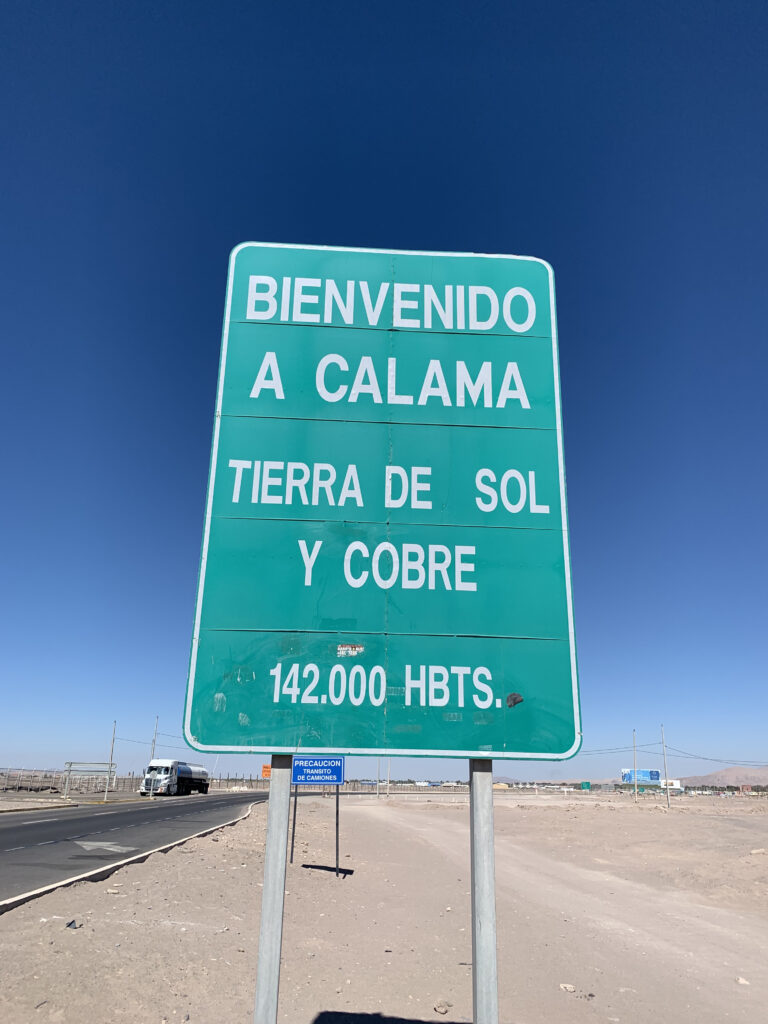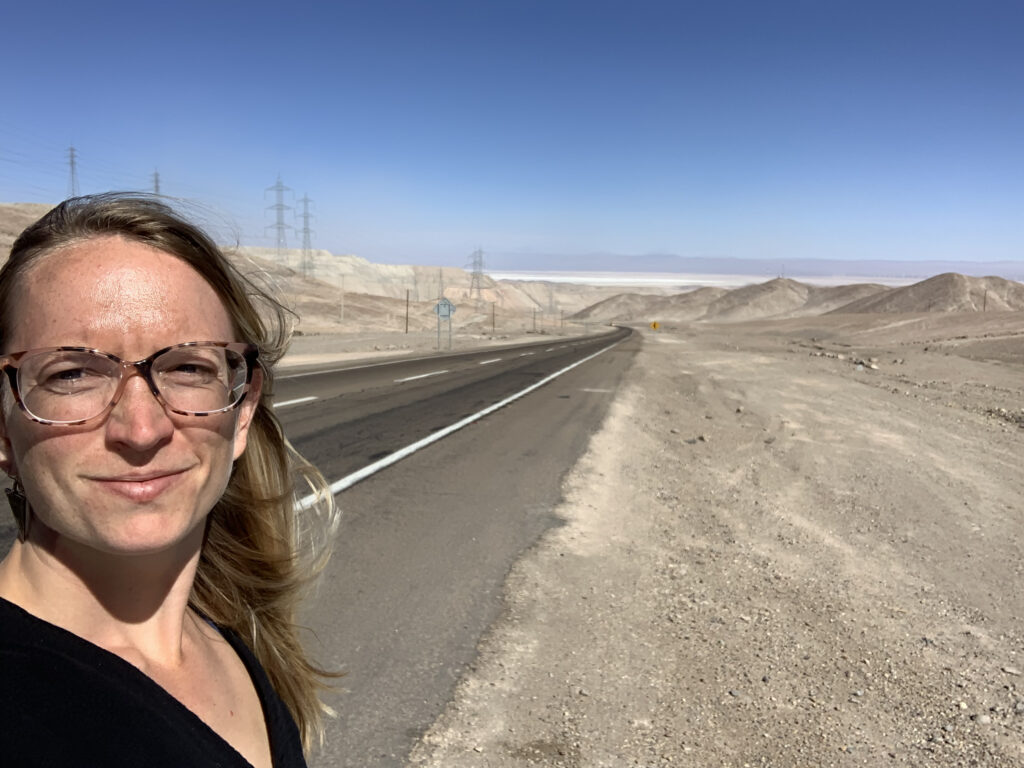Elena Louder 2021 Field Report
Renewing Injustice? A Multi-Scalar Analysis of Wind and Solar Energy Development in Chile’s Atacama Desert
Abstract: This research examines the sociopolitical dimensions of Chile’s energy transition. Since 2014, Chile has quadrupled its renewables capacity, and established the ambitious target of carbon neutrality by the year 2050. This shift results partially from a new policy, Energy 2050, which fomented renewables development. In this context, Chile’s Atacama Desert has emerged an epicenter of solar and wind development, yet little research examines the local dynamics of this massive social, technological, and political transformation on the ground. In affiliation with the University of Diego Portales and University of Tarapaca, this research responds to this gap through an examination of the Chilean energy transition from a multi-scalar perspective. Through document analysis, semi-structured interviews, and participant observation, it examines how policy instruments and regulations in Energy 2050 enable or constrain democratic energy governance in Chile, and traces the results of Chile’s recent policy and regulatory changes to the electricity sector. Secondly, it examines two case study areas in the Antofagasta region of the Atacama Desert, Taltal and Calama. In the case studies, it maps the web of actors behind energy projects, interrogates the local dynamics between communities and energy companies, and begins to outline out the larger political economy of renewable energy in the region. Thirdly, it explores the role of green finance in facilitating the Chilean energy transition. Preliminary findings show that recent regulatory changes have implied a perfecting of the energy market, where the privately owned transnational corporations carry out the energy transition. Furthermore, the exponential growth of renewables is directly related to energy demands from the mining sector. By linking up these various scales (global green finance, national scale policy, community dynamics in the region), it will explore the important role of indicators of ‘greenness’ which allow for continued mineral extraction and capital accumulation while obscuring contradictory impacts on the ground in the Atacama.
Keywords: energy transition; Chile; green finance; neoliberalism
CLAG Field Study Award Report
My research seeks to understand the socioecological and political dynamics of the Chilean energy transition. I do this by examining policies and discourses of the transition on the national scale, paired with an investigation of the energy transition in two case study areas in the Atacama Desert, the heart of Chile’s renewable energy revolution. Supported by the CLAG Field Study Award, I conducted six weeks of preliminary scouting research for my dissertation in Chile in fall of 2021. I divided my time between Santiago, the capital city, and various cities and towns in the Antofagasta and Arica/Parinacota regions of northern Chile, in the Atacama Desert. I cast a wide net and conducted semi-structured interviews with actors with various perspectives on the issue. In the end, that was academics (11), private sector energy company representative (1), government officials from the Ministry of Energy (4), representative from the Likán Antai Indigenous community (1), legal representative of Atacameño Indigenous communities (2), activists (2), students (7). As I was new to studying energy, and new to conducting research in northern Chile, I approached interviews in an open and general way. I presented myself as trying to get a grip on the debates and trajectory around energy policy, trying to understand the general dynamics and important socioecological issues in the Atacama Desert region, and seeking to identify key actors and issues around the energy transition. Below are key themes which came out of my field experience:
Extractivism and the connection between mining and renewable energy: I did not realize beforehand how much the meteoric rise in renewable energy was directly connected to copper mining, Chile’s most important industry. Most utility scale renewable energy projects are built via a contract between a mine and an energy company. This relates to sustainability targets of the mines, sustainability certifications in global stock markets for the energy companies, and discourses about green mining and sustainability. This made me think about green capitalism, and the ecological fixes to crisis tendencies produced by extractive economies.

This was my first time around extraction of that scale. In my scouting trip, I rented a car in Calama and did a road trip- three hours to Antofagasta, five hours up to Mejillones, a town with thermoelectric powerplants supplying energy to one of the world’s largest open pit copper mines, Chuquicamata. I then proceeded all the way up to Arica, just south of the Peruvian border and then back down to Calama. In my trip, I met with various actors to conduct interviews, and immersed for the first time in the desert landscape. Driving through miles and miles of copper mines, high tension wires, and massive industrial vehicles, the visceral experience and aesthetics of the landscape were very powerful.
Another theme that came up multiple times is the development of Green Hydrogen- hydrogen fuel produced using renewable energy from wind and solar which could replace diesel in various industrial processes and the transportation sector. Although this is in early stages (only a few pilot projects at present) it looms large in the minds of government officials and private sector leaders. This is connected to larger discourses/imaginaries of Chile emerging as a world leader in green energy export. This is nowhere better encapsulated than a proposal by former president Piñera, who had just proposed an undersea cable transporting green energy to China.

Regional dynamics and tensions: A key issue in the region is lithium mining in the salt flats which pepper the region. This is a growing interest of scholarly attention, and there are intense political conflicts surrounding it. One of the key tensions involves injections of money by lithium companies into local Indigenous communities, where there are hot debates about who represents different Indigenous groups, and divergent attitudes toward negotiating with lithium companies. The lithium issue made me think about how the raw materials of sustainability transitions in the global north come from the Atacama- the increased need for copper, and the demand for lithium for electric things- with similar colonial/extractive dynamics as in the past. This was a theme which many of my interlocutors were very frank about. Global interconnections and unevenness between spaces of sustainability and its extractive others is a theme I am exploring in my ongoing dissertation research.
Centralization/tensions between scales and lack of regional power: Multiple interviewees brought up the issue that the Atacama is peripheral to decision making power which is concentrated in Santiago. This manifests in specific ways, in tension between regional leaders like the presidential delegate, who is appointed by the president, as well as regional heads of ministries (mining, energy) who are also appointed by the president. Furthermore, as one interviewee pointed out, the regional actors who do hold substantial power are affiliated with mining and energy interests (e.g., industrial trade associations). So, efforts to leave more benefits behind from mining, energy, lithium, for regional development, may not be a priority. This is related to the fact that the major cities in the region have high levels of poverty and pollution: “internal colony” was mentioned multiple times as a concept to capture this sentiment.

Thanks to the support of the CLAG Field Study Award, I was able to solidify key relationships with collaborators at the Universidad de Diego Portales and the Universidad de Tarapaca, gain familiarity with the complicated social and political landscape of the Atacama Desert, and establish a solid base for my long-term dissertation fieldwork. Thank you!
Please see the full report for more details.


















